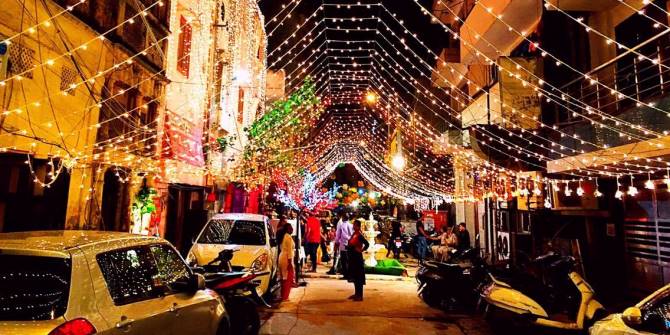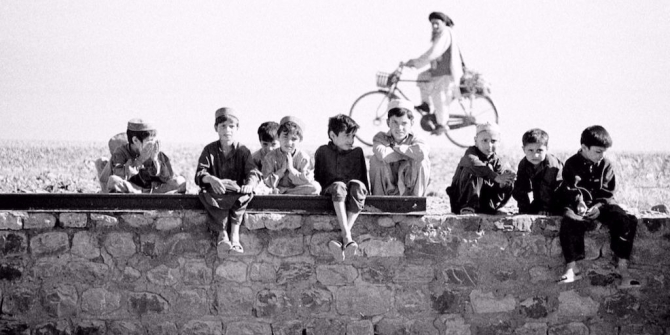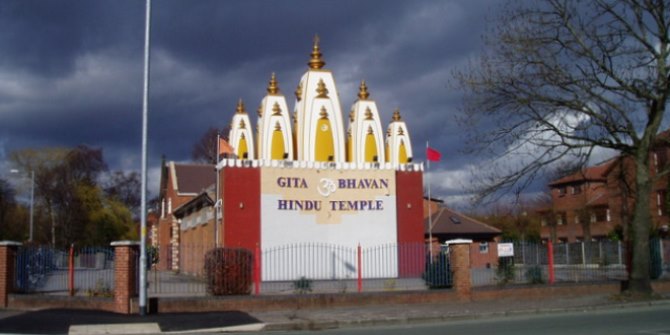 On Wednesday 5th November, LSE Visiting Fellow Dr Sheba Saeed will be screening her film Beggars of Lahore on the LSE Campus. Here she talks about what inspired her to make the documentary and the challenges of putting together such an emotionally demanding piece.
On Wednesday 5th November, LSE Visiting Fellow Dr Sheba Saeed will be screening her film Beggars of Lahore on the LSE Campus. Here she talks about what inspired her to make the documentary and the challenges of putting together such an emotionally demanding piece.
According to a recent Human Development report almost half of Pakistan’s population is now living below the poverty line. Within this segment there is a large and increasing number of beggars. The beggar population is heterogenous in nature, encompassing a diverse range of ages, genders including transgender, and ability with many disabled beggars visible on the streets of Pakistan’s towns and cities.
 Exact numbers for the beggar population are difficult to ascertain, because of their peripatetic nature and the fact many are linked to illegal networks. Places of encounter are usually those that are busy: traffic lights, shopping centres, shrines and other holy places where beggars can expect to meet donors that will readily or under coercion donate alms to them. (Saeed, 2007)
Exact numbers for the beggar population are difficult to ascertain, because of their peripatetic nature and the fact many are linked to illegal networks. Places of encounter are usually those that are busy: traffic lights, shopping centres, shrines and other holy places where beggars can expect to meet donors that will readily or under coercion donate alms to them. (Saeed, 2007)
“Beggars of Lahore” is a documentary film which takes the viewer on a journey into the streets of Lahore, Pakistan’s second largest city and cultural hub, to discover what compels the beggars to beg, what measures have been introduced by the government and NGOs to assist the beggars and whether there are any solutions to alleviate or even eradicate the issue of begging.
The idea of researching this topic first came to me whilst I was on holiday with my family in 2004, a year before I went out into the field to begin what became a film that would comprise part of my MPhil in History, Film and Television. I was taking a break from my day job as a solicitor in the UK and visiting my cultural roots, many years since my first visit as a little girl. I was also visiting the home in Lahore that was built under the close eye of my Father before he passed away in 1995. It was a very emotional experience as I explored a place that I belonged to yet had only just discovered. One of the things that preoccupied me most was the vast number of beggars, something which I hadn’t seen to that scale in the UK where I was born and raised.
The film was first shot in the summer of 2005, although with re-editing and distribution the production of the film is now nearing a decade. Conducting research on the streets in the inner city was a challenge. The whole process of getting hold of interviewees is often difficult in itself, but filming on the streets in Lahore was particularly challenging. Any foreign person in a new geographical setting has to be careful whether male or female but I was particularly aware of my vulnerability as I began to consider street interviews. As a result I formed a team of two close male cousins, who knew the locale, and my sister to work with me in the field. Even with the team, it was difficult to persuade the beggars to agree to interviews. It was only after many visits and after building a rapport with communities of beggars in different locales that I was able to film.
The process highlighted how complex the network in Lahore is, with different “categories” of beggar, some who evoke more sympathy than others. In the documentary, I offer examples in attempt to give the viewer an overview of the diversity.
“I found it emotionally upsetting to see examples of very old men and women begging. Several questions arose in my mind. Did these people have families? Were they destitute? What had the state provided for them? What was their future? Back home in Britain, the most I have ever needed to do for a senior citizen is to get up from my seat in a bus, but here, what could I do for these elderly people; give them money for temporary relief? Likewise the children, were a worry. A six year old girl in rags begging in traffic, eight or nine year old drug-addicted boys, a young boy of, at the most, fourteen, wheeling about in a trolley with an obvious disability with his legs, another young boy with burns, begging instead of going to college. What had led these children to the streets?
Those with deformities or disabilities were the most visually striking: endless examples of men and women with mutilations…the blind man whose face was disfigured who swayed his head from side to side, repeatedly crying ‘Yallah, Yallah’. Why was he crying to God as a last resort? Was the State helping him? Had attempts been made to help other people in similar circumstances? If attempts had been made, why were these people on the street?” (Saeed, 2007)
Having witnessed the plight of these beggars first hand, it was a challenge to put the documentary together in an objective manner. However, in order to create awareness of a very complex phenomenon it was important to do so. The film examines the political, social, religious, reasons for begging as well as the growth of the beggar mafia. It includes case studies of beggars and interviews with Cricketer/Politician Imran Khan, Advocate/Human Rights activist Hina Jilani, Former Chief Minister of Punjab, Chaudhry Parvez Elahi, amongst many others from both the public and private sphere as well as the general public.
Many different solutions are given by the experts interviewed which range from more assistance from the government to more practical work from the NGOs to enforcing laws that are already in place. I personally don’t dictate any one solution but do believe that an amalgamation of the solutions by these experts would go some way towards alleviating this issue and a definite move towards the right direction would be more collaboration between NGOs and the government.
The film has been screened in Pakistan as well as many conferences and film festivals around the world in an attempt to create an awareness of a pressing issue which is not being given enough food for thought anywhere in the world. In doing so, I believe it is the first step to taking practical steps to assist the beggars in their plight.
The LSE Department of Media and Communications will be screening Beggars of Lahore on Wednesday 5th November, 5.00-7.30pm in Clement House (CLM 4.02). There will also be an opportunity to view a selection of exhibition prints. To find out more about the film, visit www.asetikbird.com.
About the Author
 Dr Sheba Saeed is a Solicitor by profession holds a Ph.D. from the University of Birmingham, UK. For her doctoral research she provided a critique on the regulation of begging in Mumbai using religious and secular laws in an audio-visual format with a written thesis. For her MPhil in History, Film and Television she produced and directed her debut documentary “Beggars of Lahore” as part of an audio-visual dissertation. The film has screened at International Conferences and Film Festivals.
Dr Sheba Saeed is a Solicitor by profession holds a Ph.D. from the University of Birmingham, UK. For her doctoral research she provided a critique on the regulation of begging in Mumbai using religious and secular laws in an audio-visual format with a written thesis. For her MPhil in History, Film and Television she produced and directed her debut documentary “Beggars of Lahore” as part of an audio-visual dissertation. The film has screened at International Conferences and Film Festivals.
She is currently a researcher at the University of Birmingham, and a Visiting Fellow at the London School of Economics.







